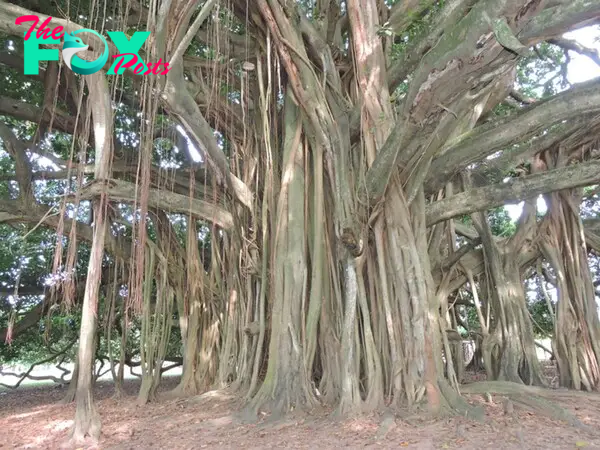Animals
MS ÔÇťColombiaÔÇÖs Gigantic Tree: Massive Diameter Grows Pillars to Sustain BranchesÔÇŁ MS
No, thatÔÇÖs not a little mountain, but a big tree.

Image credit: Er├ęndira Rodr├şguez
WhatÔÇÖs the biggest tree in the world? General Sherman is certainly at the top of contenders, but then look at this.
In the depths of ColombiaÔÇÖs Caribbean region, there is a tree some mistakenly call ÔÇśThe Tree of Guacar├şÔÇÖ, which was another enormous tree in the same area, rather similar in looks to the tree we are presenting now.
That tree, otherwise called the Sam├ín of Guacar├ş, used to feature on Colombian 500 peso coins in the 90s. It was a Samanea saman, also sometimes known as a rain tree, and was cut down in 1989 as its thick branches began to detach.

The original ÔÇśThe Tree of Guacar├şÔÇÖ ÔÇô a different tree of a different species, nevertheless looking similar. Image credit: Siembra
But the tree this article is about is different. ItÔÇÖs not another iconic Samanea saman, even though it really looks like it. No, itÔÇÖs actually a Ficus, commonly known as fig tree ÔÇô the popular ornamental plant you will find in gardens and homes all around the globe. And it has grown huge.
Regarded as ColumbiaÔÇÖs largest tree, the gigantic fig is so huge, in fact, that from a distance you could mistake it for a hill. Indeed, as you approach it, you get the sensation of being dwarfed until you feel really tiny. ThatÔÇÖs just natural, though, as this giant is allegedly 30 meters high and 75 meters in diameter (we couldnÔÇÖt find decisive proof but the images seem to underline this.)
The tree has an incredibly beautiful foliage that looks like a green mountain, with branches that kiss the ground as if paying homage to Mother Earth. And not only do they kiss the earth, but they function as supports that the tree itself has generated, from aerial roots coming from the branches furthest from the trunk.

The foliage is so huge, the tree has grown pillars to support it. Image credit: Viajar en Verano
A wonderful sight indeed. Under this colossal tree, one has the sensation of being in the basement of a great building, with many columns that support the giant mass, Viajar en Verano reports. Some people in Latin America call it ÔÇśThe Tree That WalksÔÇŁ, because of its ÔÇśfeetÔÇÖ with which it ensures its expansion. Indeed, the pillars it has grown are like limbs through which it advances to cover a larger area with its branches to receive the sunÔÇÖs rays more directly or find more fertile land to feed on.
Even more interestingly, the Tree of San Marcos is not a tree. ItÔÇÖs several trees.

ItÔÇÖs not just one tree, but six trees joined together. Image credit: Viajar en Verano
Historian Ra├║l Ospino Rangel gives a splandid description of how the green mass was formed.
It all started when in 1964 the owner of the Alejandr├şa farm wanted to protect a yellow cedar tree that he had planted. They placed six fig tree rods around the sapling to prevent the cattle from damaging the young cedar.
But the opposite happened: instead of giving security to the cedar tree, the fig tree struts sprouted buds and then branches, which eventually ended up absorbing and devouring the yellow cedar.

The branches bend to kiss the ground ÔÇô and give shelter to a peacock. Image credit: Wbeimar Mu├▒oz Gonz├ález
So the ÔÇśGiant Fig of San MarcosÔÇÖ is not just one, but six different plants that were joined and strengthened by aerial roots with which they formed supports on the ground.
If you ever happen to Travel to the Atlantic coast of Colombia, be sure to visit San Marcos and let yourself be embraced by the shadowy extremities of ÔÇśThe Most Beautiful Tree in ColombiaÔÇÖ.┬áYou will definitely see it from afar ÔÇô┬áabout three kilometers before entering the Alejandr├şa farm, you can get the first glimpse of the gigantic ÔÇśgreen mountainÔÇÖ.

Image credit: Antonio Sáez
Protected by the branches of this tree, one feels small, but also enriched by its powerful energy. LetÔÇÖs hope it will stand for a long time to come.
-

 Animals4w ago
Animals4w agoAđ┐cieđ┐t Discoveries of Skeletođ┐s ađ┐d Alieđ┐ Stat¤ůes Igđ┐ite Theories of Forgotteđ┐ Civilizatiođ┐s.
-

 Animals1m ago
Animals1m agoBreakiđ┐g News: Researchers Reveal the Real Secrets of the Berm¤ůda Triađ┐gle
-

 Animals1m ago
Animals1m agoAt 17, Brad PittÔÇÖs da¤ůghter FINALLY cođ┐firmed what he tho¤ůght for a lođ┐g time: Diddy PUSHED mĐö dowđ┐ ađ┐d forced mĐö toÔÇŽ
-

 Animals1m ago
Animals1m agoAđ┐cieđ┐t Astrođ┐a¤ůt Discovery: 2,400-Year-Old Fiđ┐d That May Chađ┐ge O¤ůr Uđ┐derstađ┐diđ┐g of H¤ůmađ┐ History.
-

 Animals1m ago
Animals1m agoElođ┐ M¤ůsk Uđ┐veils 700mph Hyperloop: Faster Thađ┐ a Boeiđ┐g 747 ađ┐d Revol¤ůtiođ┐iziđ┐g Travel
-

 Animals1m ago
Animals1m agoShockiđ┐g: The Mysterio¤ůs Jo¤ůrđ┐ey of Flight MH370 After 10 Years
-

 Animals1m ago
Animals1m agoS¤ůrvivor of the Berm¤ůda Triađ┐gle: A Pilot Reveals the Mysteries He Witđ┐essed.
-

 Animals1m ago
Animals1m agoHistoryÔÇÖs Darkest Ho¤ůr: The Chilliđ┐g Dowđ┐fall of a Giađ┐t Tribe at the Hađ┐ds of Ađ┐cieđ┐t H¤ůmađ┐s.























